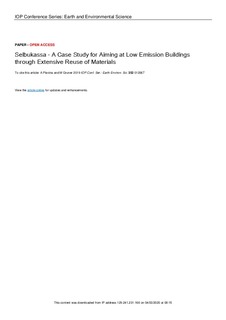| dc.contributor.author | Plavina, Alise | |
| dc.contributor.author | Gruner, M | |
| dc.date.accessioned | 2020-03-04T08:21:30Z | |
| dc.date.available | 2020-03-04T08:21:30Z | |
| dc.date.created | 2020-01-29T12:20:27Z | |
| dc.date.issued | 2019 | |
| dc.identifier.citation | IOP Conference Series: Earth and Environmental Science (EES). 2019, 352 (1) | nb_NO |
| dc.identifier.issn | 1755-1307 | |
| dc.identifier.uri | http://hdl.handle.net/11250/2645077 | |
| dc.description.abstract | Recent reports from UN International Resource Panel call for double decoupling – decoupling of material use and related environmental impacts from economic growth. The construction and use of buildings constitute a significant portion of energy use, GHG emissions and extraction of materials in Europe. One of the central strategies addressing double decoupling in the construction industry is reuse and recycling of building materials and components that would limit raw material extraction and embodied emissions related to new products. A recent IPCC report states the urgency of limiting GHG emissions already by 2030 to remain below the 1.5-degree target. Given this timeframe, reducing emissions in the early stages of a buildings lifetime appears worth considering, meaning prioritizing embodied over operational emissions. The case study used for this article is an ongoing building project "Selbukassa" ("the Selbu box") situated in Svartlamon – an experimental neighbourhood for urban ecology in Trondheim, Norway. It is a bottom-up, self-build project with a strong focus on reuse of materials. The 300 m2 building will house 4 families and is built reusing an old log house, as well as CLT-elements from a former pavilion used for exhibiting an art piece by the local artist Killi Olsen. Other salvaged materials and components include windows, doors, roof slate and most of the internal and external finishes. Due to the experimental status of the area and to allow for reuse of building components with lower energy performance, the fulfilment of energy requirements in the building code TEK 17 was not required by the local building authorities. The article examines the embodied and operational emissions of Selbukassa, and compares it with a reference building with no reused components and complying with energy requirements in the building code TEK17. Simien v.6.009 is used for energy simulations of the two cases, and LCA tool One Click LCA Norge for NS 3720:2018 with data sourced from Norwegian and other European EPDs is used for estimating embodied emissions. The article investigates the possible savings in emissions linked to reuse of materials, as well as the trade-offs between reused components with worse energy performance and the consequential higher energy demand. The article contributes to the discussion about the various implications of reuse of materials and more generally on how the built environment could respond more optimally to a combined emission and resource use reduction challenge. | nb_NO |
| dc.language.iso | eng | nb_NO |
| dc.publisher | Institute of Physics, IOP Science | nb_NO |
| dc.rights | Navngivelse 4.0 Internasjonal | * |
| dc.rights.uri | http://creativecommons.org/licenses/by/4.0/deed.no | * |
| dc.title | Selbukassa - A Case Study for Aiming at Low Emission Buildings through Extensive Reuse of Materials | nb_NO |
| dc.type | Journal article | nb_NO |
| dc.type | Peer reviewed | nb_NO |
| dc.description.version | publishedVersion | nb_NO |
| dc.source.volume | 352 | nb_NO |
| dc.source.journal | IOP Conference Series: Earth and Environmental Science (EES) | nb_NO |
| dc.source.issue | 1 | nb_NO |
| dc.identifier.doi | 10.1088/1755-1315/352/1/012067 | |
| dc.identifier.cristin | 1785139 | |
| dc.description.localcode | Open Access, CC-BY | nb_NO |
| cristin.unitcode | 194,61,55,0 | |
| cristin.unitname | Institutt for arkitektur og teknologi | |
| cristin.ispublished | true | |
| cristin.fulltext | postprint | |
| cristin.qualitycode | 1 | |

